Occupational Environment Monitoring at the Construction Materials Manufacturing Plant
99,000 ₫
Note: The above price is calculated for one sample, and the price may vary depending on the area of the environment to be monitored and market fluctuations. For more accurate pricing support, please refer to the quotation table or contact our consulting staff directly.
Occupational environment monitoring at a construction materials manufacturing plant is a process of collecting, analyzing, and evaluating workplace factors that may harm workers’ health.
Table of Contents
Toggle1. Overview of Construction Material Manufacturing Plants
a. What is a construction material manufacturing plant?
A manufacturing plant for construction materials is a production facility focused on producing essential materials used in the construction industry. This plant may manufacture and process construction materials such as cement, bricks, non-fired bricks, concrete blocks, concrete, sand, gravel, steel, insulation materials, soundproofing materials, electrical insulating materials, tiles, and many other types of materials.

b. Production stages in a construction material manufacturing plant
The production stages in a construction material manufacturing plant can vary depending on the specific material being produced. However, here are some common stages generally involved in the construction material production process:
- Raw material preparation: The first step is preparing and selecting appropriate raw materials. Materials can include cement, bricks, concrete, sand, gravel, steel, wood, etc.
- Grinding and mixing: Raw materials are ground into smaller pieces and mixed together in appropriate ratios to create a homogeneous mixture. This process is typically applied to cement, concrete, and other composite materials.
- Pressing, firing, and processing: Materials such as bricks, non-fired bricks, concrete blocks, wood, gravel, and natural stone are processed through pressing, firing, or cutting to create finished products like bricks, stone blocks, and processed wood.
- Surface treatment and tiling: This stage involves processing and treating the surface of construction materials, such as polishing, grinding, or applying waterproof coatings. Additionally, tiling materials such as ceramic tiles, mosaic tiles, and natural stone are processed and cut into tiles or small pieces for decoration and construction purposes.
- Quality control: Each production stage is checked to ensure that the final product meets quality standards and requirements.
- Packing and transportation: Once completed, construction materials are packaged and prepared for transportation to usage sites.

c. Types of machinery used in construction material manufacturing plants
Construction material manufacturing plants use various types of machinery and equipment to carry out production stages. Below are some common machines used in these plants:
- Concrete mixer: Used to mix components such as cement, sand, gravel, and water to create concrete.
- Crusher: Used to grind raw materials such as stone, gravel, or cement into smaller pieces.
- Concrete block press: Used to press concrete blocks or bricks from raw material mixtures.
- Brick cutting machine: Used to cut bricks or concrete blocks into different sizes and shapes.
- Brick extrusion machine: Used to extrude bricks such as non-fired bricks or concrete blocks.
- Concrete polishing machine: Used to polish and grind the surface of concrete products.
- Steel cutting machine: Used to cut and process steel or iron bars for construction products.
- Wood cutting machine: Used to cut and process wood panels, plywood, and MDF boards to produce construction wood products.
- Wall press machine: Used to press and compress panels, plywood, or composite plastic sheets to create construction wall products.
- Drilling and sandblasting machines: Used to drill holes or clean the surface of construction materials like concrete, stone, or wood.
- Welding machine: Used to weld steel construction joints.

d. Occupational diseases for workers in construction material manufacturing plants
Workers in construction material manufacturing plants may be exposed to certain occupational diseases related to workplace environmental factors and job characteristics. Below are some common occupational diseases in the construction material production sector:
- Respiratory diseases: Workers may be affected by dust, fumes, smoke, and chemicals during production. Common conditions include pneumonia, sinusitis, bronchitis, occupational fatigue pneumonia, and occupational lung disease.
- Skin diseases: Exposure to chemicals, oils, and other materials during production can cause skin issues such as eczema, dermatitis, irritation, and allergies.
- ENT (ear, nose, throat) diseases: Using chemicals and coloring agents in material production can irritate or damage the ears, nose, and throat, causing inflammation and discomfort.
- Noise-induced conditions: Machinery and equipment can generate high noise levels, affecting hearing and causing hearing-related illnesses.
- Spine and joint disorders: Activities like lifting heavy materials, transporting materials, and working in improper postures can lead to spine and joint injuries.
- Heat-related illnesses: Workers may face high temperatures, humidity, and thermal exposure, which can cause body temperature disorders, heat stress, and other heat-related diseases.
- Toxic exposure: Contact with hazardous chemicals such as asbestos, lead, dyes, and other toxic agents may cause serious health issues including cancer, liver, kidney, and nervous system damage.
To reduce the risk of occupational diseases, labor protection measures and adherence to occupational safety rules should be implemented in construction material manufacturing plants. This includes using personal protective equipment, ensuring good ventilation, maintaining safe working processes, and providing safety training for employees.

e. Common construction materials on the market
There are many common construction materials on the market, and below are some examples:
- Concrete: The most widely used construction material, made from cement, sand, gravel, and water. Concrete has high strength and good resistance to loads and environmental factors.
- Bricks: Traditional construction material made from clay or fired clay. Bricks have good insulation, soundproofing, and durability.
- Composite plastic bricks: Made from composite plastics, usually fiberglass combined with resin. Composite bricks are lightweight, strong, and resistant to breakage.
- Wood: A natural material used in construction for centuries. Wood has insulation, soundproofing properties, and creates a warm, natural space.
- Steel: A strong and durable construction material used in structures, frameworks, columns, and beams.
- Ceramics: Used in surfaces or decorative layers such as tiles, mosaic tiles, and cladding.
- Glass: Used in windows, doors, and walls to allow natural light and visibility.
- Cement: The primary binding material in construction, used to join materials like sand, gravel, and bricks.
- Insulation materials: Materials like fiberglass, EPS foam (expanded polystyrene), and sponges are used to insulate walls, ceilings, and floors.
- Waterproofing materials: Waterproof membranes, adhesives, and mortars are used to prevent water and moisture penetration in construction projects.
2. Overview of Workplace Environmental Monitoring Services
a. What is workplace environmental monitoring in construction material manufacturing plants?
Workplace environmental monitoring (or occupational environment measurement) in construction material manufacturing plants is the activity of collecting, evaluating, and analyzing measurement indicators of workplace environmental factors. The goal is to implement timely measures to minimize environmental harm to workers’ health and prevent occupational diseases. Workplace environmental monitoring is mandatory for construction material manufacturing plants.
Workplace environmental monitoring is crucial for protecting, maintaining, and improving workers’ health because the main resource of a business, directly generating profit, is its workforce. Workers who are frequently exposed to risk factors and occupational hazards above permissible limits will experience health impacts and occupational diseases.
REGISTER FOR WORKPLACE ENVIRONMENTAL MONITORING SERVICE
b. Nam Viet’s workplace environmental monitoring program
Nam Viet’s workplace environmental monitoring program is researched by monitoring engineers specializing in occupational safety and environmental protection. Aiming to ensure workers’ health and safety, this program employs modern measurement methods to monitor air quality, water, microclimate, physical factors, dust, and more in the workplace. This program is essential to ensure a safe working environment and protect workers’ health.
Additionally, Nam Viet’s monitoring program plays a critical role in researching and developing new solutions to improve workplace environmental quality. With a dedicated and professional team of experts, Nam Viet’s exclusive monitoring program is a breakthrough in occupational safety and environmental management in Vietnam.

c. Standardization in workplace environmental measurement procedures
Standardization in Nam Viet’s workplace environmental measurement procedures is vital to ensure the quality of results. To guarantee accuracy and reliability, the program follows standards and standardized procedures recognized by the Ho Chi Minh City Department of Health. This ensures that collected data are highly reliable for evaluating workplace environments and making decisions to improve workplace safety and protect workers’ health.
These standardized procedures also ensure that measurements are performed by experienced monitoring specialists, providing managers and experts confidence in results from An Toàn Nam Việt and enabling precise, valuable decisions for worker health and environmental protection.
By applying standardized measurement procedures, Nam Viet demonstrates its commitment to ensuring a safe working environment and protecting workers’ health while actively contributing to improving occupational safety and environmental management quality in Vietnam.
d. Reporting of workplace environmental monitoring results in construction material plants
Workplace environmental monitoring results are prepared according to Form No. 04, Appendix III, issued with Decree 44/2016/ND-CP and prepared in 2 copies: one sent to the contracting workplace and one retained by the monitoring organization.
The retention period for workplace environmental monitoring results follows legal requirements and is indefinite.

e. Frequency of workplace environmental monitoring according to law
According to Clause 2 of Article 18 of the Law on Occupational Safety and Health 84/2015/QH13, employers must organize workplace environmental monitoring to assess hazardous factors at least once a year.
f. Deadline for submitting workplace environmental monitoring reports according to law
The deadline for submission is before December 31 each year. Enterprises operating production facilities must submit workplace environmental monitoring reports to the Department of Health at the location of their headquarters and where their employees are working.
When there are changes in technology, production processes, or upgrades to the workplace that may introduce new hazardous factors, enterprises must update occupational hygiene records regarding the hazardous factors requiring monitoring.
g. Penalties for violations of workplace environmental monitoring by employers
According to Article 27 of Decree No. 12/2022/ND-CP dated January 17, 2022, on administrative penalties in labor, social insurance, and Vietnamese workers working abroad under contracts:
- Clause 2: A fine of 2,000,000 – 5,000,000 VND for employers who fail to publicly disclose monitoring results and assessments of hazardous factors to employees at the monitored workplace and evaluated site immediately after obtaining monitoring and assessment results.
- Clause 3: A fine of 20,000,000 – 40,000,000 VND for employers who fail to conduct workplace environmental monitoring to control health hazards according to legal regulations.
- Clause 4: A fine of 40,000,000 – 60,000,000 VND for employers who collude with environmental monitoring organizations to commit fraud in monitoring activities, but not to the level of criminal liability.
3. Harmful Environmental Factors for Workers in Construction Material Manufacturing Plants
When working in construction material manufacturing plants, workers may encounter the following harmful environmental factors:
- Dust: The production processes such as cutting, grinding, polishing, or transportation can generate dust. Long-term exposure to dust can cause health issues such as pneumonia, asthma, and other respiratory problems.
- Chemicals: The use of chemicals such as cement, adhesives, dyes, waterproofing agents, and other additives during production can pose health risks. These chemicals may cause skin, eye, and respiratory irritation, and can be dangerous if exposure is prolonged or improper.
- Noise: Machinery and production processes in construction material factories can generate high noise levels. Prolonged exposure can affect hearing, cause insomnia, stress, and negatively impact mood and work performance.
- Temperature and humidity: Certain manufacturing processes may create hot and humid working conditions. Continuous exposure can lead to heat stress, fatigue, and health issues such as heat exhaustion and decreased work productivity.
- Waste: Construction material production can generate waste such as dust, sand residues, chemical waste, and leftover materials. Exposure to these wastes can be hazardous and cause workplace pollution.
REGISTER FOR OCCUPATIONAL ENVIRONMENT MONITORING SERVICE
4. Measures to Improve the Working Environment in Construction Material Manufacturing Plants
To improve the working environment in construction material manufacturing plants, the following measures can be applied:
- Ventilation and dust extraction systems: Install effective ventilation and dust extraction systems to remove dust and toxic vapors from the working air. This reduces the risk of exposure to dust and harmful chemicals.
- Personal protective equipment (PPE): Ensure workers are fully equipped with and use PPE such as masks, safety glasses, gloves, protective clothing, and helmets. This protects them from direct exposure to chemicals, dust, and other environmental hazards.
- Training and guidance: Ensure workers receive training on occupational safety and hygiene. They should know how to properly use PPE, follow safe work procedures, and handle waste correctly.
- Equipment inspection and maintenance: Conduct regular inspections and maintenance of factory equipment and machinery. This ensures proper functioning and reduces potential hazards for workers.
- Waste management: Handle waste safely and comply with waste management regulations. Ensure that waste is collected, transported, and treated legally without polluting the environment.
- Workplace organization: Arrange the workspace to minimize the risk of collisions, slips, falls, and occupational accidents. Ensure a tidy workspace, safely stacked materials, and unobstructed movement and operations.
- Periodically perform occupational environment monitoring in the factory, collect and analyze harmful factors for workers, and adjust to reduce hazards to prevent occupational diseases.
5. Benefits of Periodic Monitoring in Construction Material Manufacturing Plants
An Toan Nam Viet provides enterprises with excellent benefits when using occupational environment monitoring services according to Decree 44/2016/ND-CP on management and control of harmful factors in the working environment affecting employees.
- Enterprises can proactively control harmful factors in workshops or factories.
- Receive recommendations on measures to minimize harmful factors and improve the working environment.
- Indirectly protect human resources, the main factor in business development.
- Reduce the impact of occupational diseases on health, thereby lowering future treatment costs.
- Improve workers’ health, ensuring product quality and maintaining production output.
- Comply with occupational safety laws, avoiding legal risks.
- Enhance credibility and professionalism in all aspects, elevating the enterprise’s brand.
Nam Viet’s environmental monitoring service is a solution to minimize occupational disease risks, contributing to a clean and high-quality working environment.

6. Nationwide Occupational Environment Monitoring Center
The Occupational Environment Monitoring Center of Nam Viet is a professional unit specializing in supervising and measuring occupational environment quality across all provinces in Vietnam. With a team of experienced monitoring specialists, the center uses modern measurement equipment to ensure accuracy and reliability.
In addition to providing monitoring services, the center assists clients in planning, handling, and tracking occupational environment issues. With the motto “customers at the center,” the center prioritizes client satisfaction, meets all client needs, and commits to providing the best solutions for businesses.
REGISTER FOR OCCUPATIONAL ENVIRONMENT MONITORING SERVICE
With investments in technology, equipment, and personnel, Nam Viet’s monitoring center has become a reputable unit in occupational environment monitoring in Ho Chi Minh City, with the following objectives:
- We always value brand reputation and service quality.
- We provide clients with the best and most suitable solutions possible.
- Alongside a team of experienced Masters and Engineers committed to environmental protection and business benefit.
- By working with Nam Viet Environmental Monitoring, your company will receive professional service from field experts and enjoy the best cost advantages.
The occupational environment monitoring process at Nam Viet includes the following basic steps:
- Before monitoring, we ensure that all equipment is calibrated according to legal regulations.
- Strictly follow the occupational environment monitoring procedures committed to the Department of Health.
- Report monitoring results honestly to the employer.
- If results indicate unsafe conditions for workers, Nam Viet provides solutions, and the workplace will:
- Implement measures to improve working conditions to minimize harmful effects and prevent occupational diseases.
- Organize health examinations to detect occupational and work-related diseases early for employees in unsafe positions.
- Provide material compensation for workers according to labor law regulations.

7. Occupational Environment Monitoring Pricing
To help enterprises conduct professional and effective occupational environment monitoring, Nam Viet provides customers with a detailed and reasonably priced service quotation.
- Our pricing table provides detailed information on the costs of monitoring services, including travel, measurement, analysis, and reporting fees. Clients can rely on the accuracy and reliability of our monitoring reports.
- We commit to offering the most competitive and reasonable prices on the market and are always ready to provide fast and professional consultation on monitoring services.
- With Nam Viet’s quotation table, clients can easily select service packages that suit their needs. We guarantee maximum satisfaction with our professional service quality.
No comments yet

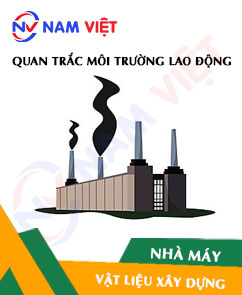
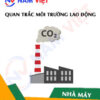
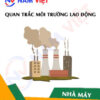
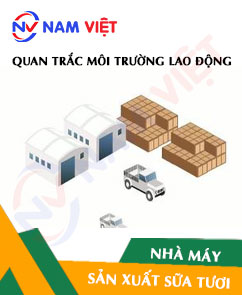




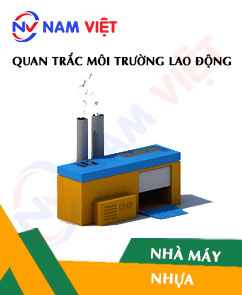


Review Occupational Environment Monitoring at the Construction Materials Manufacturing Plant
There are no reviews yet.